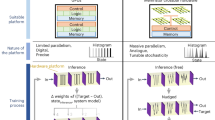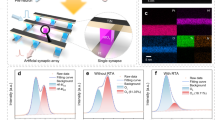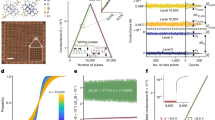Abstract
Memristor-based platforms could be used to create compact and energy-efficient artificial intelligence (AI) edge-computing systems due to their parallel computation ability in the analogue domain. However, systems based on memristor arrays face challenges implementing real-time AI algorithms with fully on-device learning due to reliability issues, such as low yield, poor uniformity and endurance problems. Here we report an analogue computing platform based on a selector-less analogue memristor array. We use interfacial-type titanium oxide memristors with a gradual oxygen distribution that exhibit high reliability, high linearity, forming-free attribute and self-rectification. Our platform—which consists of a selector-less (one-memristor) 1 K (32 × 32) crossbar array, peripheral circuitry and digital controller—can run AI algorithms in the analogue domain by self-calibration without compensation operations or pretraining. We illustrate the capabilities of the system with real-time video foreground and background separation, achieving an average peak signal-to-noise ratio of 30.49 dB and a structural similarity index measure of 0.81; these values are similar to those of simulations for the ideal case.
This is a preview of subscription content, access via your institution
Access options
Access Nature and 54 other Nature Portfolio journals
Get Nature+, our best-value online-access subscription
$32.99 / 30 days
cancel any time
Subscribe to this journal
Receive 12 digital issues and online access to articles
$119.00 per year
only $9.92 per issue
Buy this article
- Purchase on SpringerLink
- Instant access to full article PDF
Prices may be subject to local taxes which are calculated during checkout




Similar content being viewed by others
Data availability
The data that support the plots within this article and other findings of this study are available from the corresponding author upon reasonable request.
Code availability
The code used for the simulation is available from the corresponding author upon reasonable request.
References
Verbraeken, J. et al. A survey on distributed machine learning. ACM Comput. Surv. 53, 30 (2020).
Masanet, E., Shehabi, A., Lei, N., Smith, S. & Koomey, J. Recalibrating global data center energy-use estimates. Science 367, 984–986 (2020).
Yu, W. et al. A survey on the edge computing for the Internet of Things. IEEE Access 6, 6900–6919 (2018).
Li, E., Zeng, L. K., Zhou, Z. & Chen, X. Edge AI: on-demand accelerating deep neural network inference via edge computing. IEEE Trans. Wirel. Commun. 19, 447–457 (2020).
Take it to the edge. Nat. Electron. 2, 1 (2019).
Satyanarayanan, M., Bahl, P., Cáceres, R. & Davies, N. The case for VM-based cloudlets in mobile computing. IEEE Pervasive Comput. 8, 14–23 (2009).
Cao, K. Y., Liu, Y. F., Meng, G. J. & Sun, Q. M. An overview on edge computing research. IEEE Access 8, 85714–85728 (2020).
Murshed, M. G. S. et al. Machine learning at the network edge: a survey. ACM Comput. Surv. 54, 170 (2021).
Yao, P., Gao, B. & Wu, H. Transforming edge hardware with in situ learning features. Nat. Rev. Electr. Eng. 1, 141–142 (2024).
Zhang, W. Q. et al. Neuro-inspired computing chips. Nat. Electron. 3, 371–382 (2020).
Song, M. K. et al. Recent advances and future prospects for memristive materials, devices, and systems. ACS Nano 17, 11994–12039 (2023).
Wang, Z. R. et al. Reinforcement learning with analogue memristor arrays. Nat. Electron. 2, 115–124 (2019).
Liu, Q. et al. Proc. 2020 IEEE International Solid-State Circuits Conference (ISSCC) (IEEE, 2020).
Hung, J. M. et al. A four-megabit compute-in-memory macro with eight-bit precision based on CMOS and resistive random-access memory for AI edge devices. Nat. Electron. 4, 921–930 (2021).
Kim, H., Mahmoodi, M. R., Nili, H. & Strukov, D. B. 4K-memristor analog-grade passive crossbar circuit. Nat. Commun. 12, 5198 (2021).
Choi, S. et al. SiGe epitaxial memory for neuromorphic computing with reproducible high performance based on engineered dislocations. Nat. Mater. 17, 335–340 (2018).
Wu, W. et al. Proc. 2018 IEEE Symposium on VLSI Technology (IEEE, 2018).
Li, C. et al. Efficient and self-adaptive in-situ learning in multilayer memristor neural networks. Nat. Commun. 9, 2385 (2018).
Park, S. O. et al. Linear conductance update improvement of CMOS-compatible second-order memristors for fast and energy-efficient training of a neural network using a memristor crossbar array. Nanoscale Horiz. 8, 1366–1376 (2023).
Rao, M. Y. et al. Thousands of conductance levels in memristors integrated on CMOS. Nature 615, 823–829 (2023).
Zhang, W. B. et al. Edge learning using a fully integrated neuro-inspired memristor chip. Science 381, 1205–1211 (2023).
Yao, P. et al. Fully hardware-implemented memristor convolutional neural network. Nature 577, 641–646 (2020).
Wan, W. E. et al. A compute-in-memory chip based on resistive random-access memory. Nature 608, 504–512 (2022).
Alibart, F., Gao, L. G., Hoskins, B. D. & Strukov, D. B. High precision tuning of state for memristive devices by adaptable variation-tolerant algorithm. Nanotechnology 23, 075201 (2012).
Milo, V. et al. Accurate program/verify schemes of resistive switching memory (RRAM) for in-memory neural network circuits. IEEE Trans. Electron Devices 68, 3832–3837 (2021).
Yao, P. et al. Face classification using electronic synapses. Nat. Commun. 8, 15199 (2017).
Yan, B. N., Yang, J. H., Wu, Q., Chen, Y. R. & Li, H. Proc. 2017 IEEE/ACM International Conference on Computer-Aided Design (ICCAD) (IEEE, 2017).
Liu, X. X. et al. Harmonica: a framework of heterogeneous computing systems with memristor-based neuromorphic computing accelerators. IEEE Trans. Circuits Syst. I Regul. Pap. 63, 617–628 (2016).
Xia, Q. F. & Yang, J. J. Memristive crossbar arrays for brain-inspired computing. Nat. Mater. 18, 309–323 (2019).
Ielmini, D. & Pedretti, G. Device and circuit architectures for in-memory computing. Adv. Intell. Syst. 2, 2000040 (2020).
Park, S. O., Jeong, H., Park, J., Bae, J. & Choi, S. Experimental demonstration of highly reliable dynamic memristor for artificial neuron and neuromorphic computing. Nat. Commun. 13, 2888 (2022).
Kim, K. M. et al. Low-power, self-rectifying, and forming-free memristor with an asymmetric programing voltage for a high-sensity crossbar application. Nano Lett. 16, 6724–6732 (2016).
Li, C. et al. Three-dimensional crossbar arrays of self-rectifying Si/SiO2/Si memristors. Nat. Commun. 8, 15666 (2017).
Candès, E. J., Li, X., Ma, Y. & Wright, J. Robust principal component analysis? J. ACM 58, 11 (2011).
Han, S., Cho, E.-S., Park, I., Shin, K. & Yoon, Y.-G. Efficient neural network approximation of robust PCA for automated analysis of calcium imaging data. In Proc. Medical Image Computing and Computer-Assisted Intervention (MICCAI) 2021: 24th International Conference Part VII 24 (eds de Bruijne, M. et al.) 595–604 (Springer, 2021).
Chen, P. et al. Proc. 2023 IEEE International Solid-State Circuits Conference (ISSCC) (IEEE, 2023).
Yang, Y., Nagarajaiah, S. & Ni, Y. Q. Data compression of very large‐scale structural seismic and typhoon responses by low‐rank representation with matrix reshape. Struct. Control Health Monit. 22, 1119–1131 (2015).
Ohno, T. et al. Short-term plasticity and long-term potentiation mimicked in single inorganic synapses. Nat. Mater. 10, 591–595 (2011).
Wang, Z. et al. Memristors with diffusive dynamics as synaptic emulators for neuromorphic computing. Nat. Mater. 16, 101–108 (2017).
Wan, J. et al. Efficient implementation of synaptic learning rules for neuromorphic computing based on plasma-treated ZnO nanowire memristors. J. Phys. D 53, 055303 (2019).
Grossi, A. et al. Impact of intercell and intracell variability on forming and switching parameters in RRAM arrays. IEEE Trans. Electron Devices 62, 2502–2509 (2015).
Abbas, Y. et al. Compliance-free, digital SET and analog RESET synaptic characteristics of sub-tantalum oxide based neuromorphic device. Sci. Rep. 8, 1228 (2018).
Siegel, S. et al. Trade‐off between data retention and switching speed in resistive switching ReRAM devices. Adv. Electron. Mater. 7, 2000815 (2021).
Ambrogio, S. et al. Equivalent-accuracy accelerated neural-network training using analogue memory. Nature 558, 60–67 (2018).
Li, C. et al. Analogue signal and image processing with large memristor crossbars. Nat. Electron. 1, 52–59 (2018).
Cai, F. X. et al. A fully integrated reprogrammable memristor-CMOS system for efficient multiply-accumulate operations. Nat. Electron. 2, 290–299 (2019).
Wu, H., Judd, P., Zhang, X., Isaev, M. & Micikevicius, P. Integer quantization for deep learning inference: principles and empirical evaluation. Preprint at https://arxiv.org/abs/2004.09602 (2020).
Cho, J., Han, S., Cho, E.-S., Shin, K. & Yoon, Y.-G. Proc. 2023 IEEE/CVF Winter Conference on Applications of Computer Vision (WACV) (IEEE, 2023).
Acknowledgements
This work was supported by the National Research Foundation (NRF) funded by the Korean government (MSIT) (grant nos. RS-2024-00401234 to H.J., S.-O.P., J.B., T.J., Y.C., S.S., T.P. and S.C.; 2022M3I7A2078273 to H.J., S.-O.P., J.B., T.J., Y.C., S.S., H.-J.J., S.P., T.P. and S.C.; 2022M3F3A2A01072851 to H.J., S.-O.P., J.B., T.J., Y.C., S.S., H.-J.J., S.P., T.P., J.O., J.P., D.J., I.K. and S.C.; RS-2023-00209473 to S.H. and Y.-G.Y.; and 2020R1C1C1007464 to H.J., S.-O.P., T.R.K., J.B., T.J., Y.C., S.S., H.-J.J., S.P., T.P. and S.C.) and Institute of Information & Communications Technology Planning & Evaluation (IITP) grant funded by the Korea government (MSIT) (grant no. RS-2023-00216370 to K.K. and K.-H.K.).
Author information
Authors and Affiliations
Contributions
H.J., S.H., S.-O.P., Y.-G.Y. and S.C. conceived this work. H.J., S.H., Y.-G.Y. and S.C. designed the experiments and overall simulation. H.J., S.-O.P., H.-J.J. and T.J. designed and fabricated the memristor array. H.J., S.-O.P., J.B., S.S. and T.P. performed material analysis. H.J., J.B. and Y.C. conducted electrical measurement of the device. H.J., T.R.K., S.P., J.O., J.P., D.J. and I.K. designed the analogue computing unit. S.H. designed the video processing. H.J. and S.H. designed the real-time platform. H.J., S.H., K.K. and K.-H.K. conducted and improved the video processing implementation. H.J., S.H., S.-O.P., Y.-G.Y. and S.C. prepared the manuscript. All authors contributed to the discussion and analysis of the results regarding the manuscript. Y.-G.Y. and S.C. supervised the study.
Corresponding authors
Ethics declarations
Competing interests
The authors declare no competing interests.
Peer review
Peer review information
Nature Electronics thanks Muhammad Khan, Kyusang Lee and Guangdong Zhou for their contribution to the peer review of this work.
Additional information
Publisher’s note Springer Nature remains neutral with regard to jurisdictional claims in published maps and institutional affiliations.
Supplementary information
Supplementary Information
Supplementary Figs. 1–31, Discussion and Tables 1 and 2.
Supplementary Video 1
Real-time video foreground and background separation using the developed platform with 1 K highly reliable selector-less memristor array.
Rights and permissions
Springer Nature or its licensor (e.g. a society or other partner) holds exclusive rights to this article under a publishing agreement with the author(s) or other rightsholder(s); author self-archiving of the accepted manuscript version of this article is solely governed by the terms of such publishing agreement and applicable law.
About this article
Cite this article
Jeong, H., Han, S., Park, SO. et al. Self-supervised video processing with self-calibration on an analogue computing platform based on a selector-less memristor array. Nat Electron 8, 168–178 (2025). https://doi.org/10.1038/s41928-024-01318-6
Received:
Accepted:
Published:
Issue date:
DOI: https://doi.org/10.1038/s41928-024-01318-6
This article is cited by
-
Self-rectifying memristors with high rectification ratio for attack-resilient autonomous driving systems
Nature Communications (2025)
-
Video processing on a self-calibrating analogue memristor array
Nature Electronics (2025)



